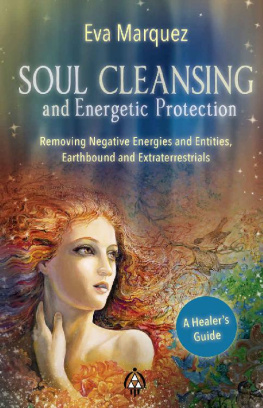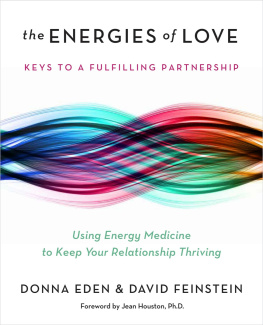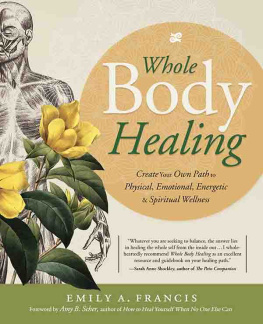I first want to thank the amazing teachers that have graced my life. Ismail Daim, also known as the Bomoh, accepted me as an apprentice and generously shared with me the ancient wisdom from his indigenous healing practices of the jungles of Borneo and the Unani tradition that have transformed my life, brought healing to many and expanded my perception of reality. Tenzin Wangyal Rinpoche, Marcy Vaughn and Gabriel Rocco brought the rich teachings of the Bn Buddhists into my heart and soul providing a daily practice that brings both joy and peace to my life and is the foundation for the work that I do. The first time that I met Robert Bosnak, a renowned Jungian analyst, he asked me a simple question, Where does your mothers energy live within you? which awakened me to the reality of the energetic dimension of ones being.
Ellen Szabo, a gifted writer and teacher, brought form and structure to this book and urged me to paint pictures with words to convey the heart of the message. Patty Gift generously offered her time and considerable skill in guiding me through the process of creating a book proposal and of the importance of creating a social media platform. Roz Cummins tirelessly edited the book and with great humor attempted to teach me the ins and out of social media, a skill that I have yet to master. Her patience, warmth and encouragement has been a true gift and much appreciated. Michael Cooper, the publisher of my first book and a dear friend, served as a guide, critic and editor, alerting me to those moments when I became a bit too preachy or far out there. I want to thank all of the folks at O-Books for believing in my work and for bringing it to life and into the world. I want to thank my dear brothers and sisters of the Three Doors community for their ongoing love and support with a special shout out to my tarp sisters.
Most importantly I want to offer profound gratitude for all of my spirit guides and power animals who used me as the vehicle to bring their teachings into the world. I did not write this book; they wrote it through me.
Andrews, Shirley. Atlantis: Insights from a Lost Civilization. St. Paul, MN: Llewellyn Publications, 1997.
Brennan, Barbara. Hands of Light. New York: Bantam Books, 1987.
Byrne, Rhonda. The Secret. New York: Atria Books, 2006.
Dickson, MG. A Sarawak Anthology. London: University of London Press Ltd., 1965.
Drake, AM. Healing of the Soul: Shamanism and Psyche. Ithaca, NY: Busca, Inc., 2003.
Eliade, Mircea. Shamanism: Archaic Techniques of Ecstasy. New York: Pantheon, 1964.
Harner, Michael. The Way of the Shaman. New York: Harper, 1980.
Ingerman, Sandra. Soul Retrieval: Mending the Fragmented Self. New York: HarperCollins, HarperSanFrancisco, 1990.
Judith, Anodea, and Selene Vega. The Sevenfold Journey: Reclaiming Mind, Body & Spirit Through the Chakras. Freedom, CA: The Crossing Press, 1993.
Jung, CG. Modern Man In Search of a Soul. New York: Harcourt, Brace & World, Inc., 1933.
Mindell, Arnold. Dreambody: The Bodys Role in Revealing the Self. Boston: Sigo Press, 1982.
Mullen, Vernon. The Story of Sarawak. Kuala Lumpur: Oxford University Press, 1967.
Schwartz, Richard C. Introduction to the Internal Family Systems Model. Oak Park, IL: Trailheads, 2001.
Sharamon, Shalila, and Bodo J. Baginski. The Chakra-Handbook. Wilmot, WI: Lotus Light Publications/Shangri-La, 1988.
Stevens, Jose, and Lena S. Stevens. Secrets of Shamanism: Tapping the Spirit Power Within You. New York: Avon, 1988.
Stevens, Jose, and Simon Warwick-Smith. The Michael Handbook: A Channeled System for Self Understanding. Sonoma, CA: Warwick Press, 1990.
Talbot, Michael. The Holographic Universe. New York: HarperCollins Publishers, 1991.
Tolle, Eckhart. A New Earth: Awakening to Your Lifes Purpose. London: Plume Books, 2006.
Weiner, Tim. Senate unit calls US most violent country on earth. Boston Globe. March 13, 1991.
Williamson, Marianne. A Return to Love: Reflections on the Principles of A Course In Miracles. New York: HarperCollins, 1992 (pp. 190191).
Winnicott, DW. The Maturational Process and the Facilitating Environment. New York: International Universities Press, Inc., 1965.
Wolf, Fred Alan. The Dreaming Universe. New York: Touchstone, 1995.
In the early 1990s, I experienced a strong pull to return to the state of Sarawak in Malaysian Borneo where I had been a Peace Corps volunteer in the late 60s. I had lived and worked for over two years in a village named Matu that was three days by boat from the nearest town. It was a peaceful idyllic village that had no awareness of the existence of the United States and believed all white people came from New Zealand. I was the first white woman they had seen. There was no running water or electricity. Everyone bathed and drank from the same water in which they relieved themselves. As a result, there was an infant mortality rate of 50%. Needless to say, it took my body some time to adjust to these conditions as well. Often, I turned to the local shamans for healing as there was no other form of health care available. Once I was quite ill with a fever of 104. The local dukun, the name given to a female shaman, massaged my tense muscles, and when she was finished, my fever was gone. I marveled at her skill, never dreaming that years later, I would perform a healing for her after she had a stroke. I had no idea at the time how she was able to heal my ravaged body, but I did know that she had magic in her hands that I had never experienced before.
Muslims arrived on the coast of Northern Borneo in the 16th century and converted the people there to Islam. Despite this fact, when I was first arrived the women were bare breasted; today they are covered from head to toe in traditional Islamic dress. I knew little about Islam when I first lived in Matu and struggled to discern which of their healing practices and traditions came from the Islamic faith and which were indigenous to Borneo. A strong belief in spirit guides, ghosts, and elemental guides was pervasive. The air was filled with magic. The energy in Borneo was markedly different from the United States, as if life existed on a different frequency or vibration. I was quite happy living there and felt a peace and connection to nature that I had not experienced in America. I had frequent dj vu experiences while living in Matu opening me to consider the existence of past lives.
Before going into the Peace Corps, I had been quite interested in politics and the public arena, majoring in political science in college and minoring in history. In my time in Borneo I felt a pull to go inward. Upon my return, I was drawn to explore the psychological and spiritual aspects of existence. My husband was at Harvard Divinity School. I carried a secret longing that I could go there as well. Instead, I went to graduate school to become a school psychologist and then to start a family. After a twelve-year hiatus, I returned to graduate school to earn a doctorate in clinical psychology.
At the time of my return visit, I was working as a clinical psychologist in private practice and taught in a doctoral program in clinical psychology. My specialty was working with people who had experienced severe emotional, physical and sexual trauma, including those with dissociative identity disorder (DID), also known as multiple personality disorder. Often, I pondered how it was that one personality could inhabit a body and then seconds later a totally different being was before me. Frequently the various personalities had dissimilar physiology with one personality wearing glasses and the other with perfect sight. In another instance one personality had a severe case of asthma whereas the others were free of all asthmatic symptoms. Where did one personality or alter go when the other appeared, and how was it that the physical body was so different from one alter to the next? I could always tell in an instant which alter was with me as each looked, sounded and acted differently. A different energy about each one was apparent, as if an entirely different vibration ran through the body.






